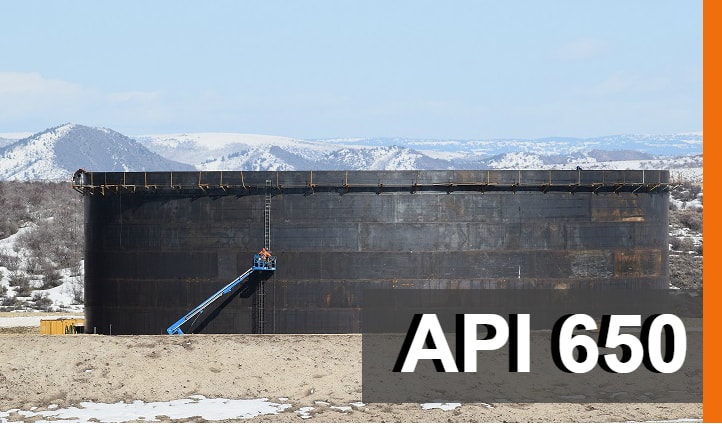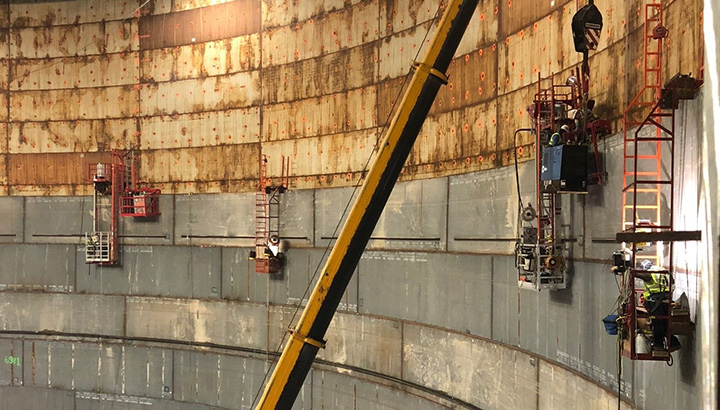Understanding the Standards That Govern API 650 Welding Inspection
Just How Welding Evaluation Works: A Comprehensive Overview for Professionals
Welding assessment plays a crucial role in guaranteeing the safety and dependability of bonded structures. It involves a methodical technique that consists of both aesthetic inspection and advanced screening methods. Specialists need to acquaint themselves with essential standards and regulations regulating the market. Recognizing the common issues that can develop throughout welding is necessary. This guide will explore these components in detail, giving insights right into the procedures that support high quality and stability in welding.
Recognizing the Value of Welding Evaluation
While numerous might ignore the relevance of welding evaluation, it plays an important role in making certain the stability and security of bonded structures. Efficient welding assessment determines possible problems and imperfections that can compromise structural stamina and cause disastrous failings. The evaluation process includes different strategies, such as visual assessments, ultrasonic testing, and radiographic evaluations, each contributing to the overall assessment of weld high quality.
Along with safeguarding the architectural stability, welding inspection assures compliance with industry requirements and client specifications. By guaranteeing that welds satisfy called for characteristics and tolerances, inspections help preserve the dependability and durability of components in numerous applications, from building and construction to aerospace. Moreover, a strenuous assessment procedure fosters a society of quality and liability among welders and producers. Eventually, welding inspection is not just a step-by-step action; it is a vital method that underpins the security and efficiency of crafted systems across diverse markets.
Secret Requirements and Rules in Welding Inspection
The structure of reliable welding assessment rests on adherence to established criteria and policies. Different companies, such as the American Welding Society (AWS) and the American National Specification Institute (ANSI), established forth standards that ensure top quality and safety and security in welding techniques. Trick criteria, such as AWS D1.1 for structural welding and ASME Section IX for pressure vessels, supply comprehensive standards for welding procedures, credentials, and assessments. Regulatory frameworks, consisting of those from the Occupational Safety And Security and Wellness Management (OSHA), mandate safety and security methods and employee protections in welding settings. Conformity with these requirements is important for achieving consistent weld quality and lessening the risk of failings. Furthermore, international criteria like ISO 3834 even more boost worldwide uniformity in welding inspection practices. Professionals should remain notified concerning these guidelines to guarantee that their inspection techniques align with sector expectations and legal demands, consequently protecting both workers and structural integrity.
Initial Preparation and Visual Evaluation Techniques

Efficient welding evaluation begins with a complete pre-inspection checklist that ensures all required conditions are met prior to the real examination occurs. Following this preparation, aesthetic problem identification plays a crucial role in assessing weld high quality, enabling assessors to identify problems such as fractures or incorrect fusion. With each other, these strategies develop the foundation for an effective welding evaluation process.
Pre-Inspection Checklist
Before beginning any type of welding inspection, a complete pre-inspection list is important to guarantee that all necessary preparations are finished and that aesthetic evaluation methods are successfully employed. Crucial element of this list consist of validating the welding procedure requirements (WPS), making certain all equipment is calibrated and in great working problem, and verifying that the inspector has the needed accreditations. Furthermore, it is important to examine any kind of previous examination reports and to evaluate the job environment for safety threats. The examiner ought to additionally validate that all relevant documents, such as product certificates and evaluation documents, is conveniently available. Completing this checklist helps to establish a solid structure for a successful inspection process, boosting the dependability of the results acquired.
Aesthetic Flaw Identification
An effective visual problem identification process begins with cautious first preparation and the application of well-known visual evaluation methods. Inspectors ought to ensure that the welding area is tidy and well-lit, as sufficient visibility is important for finding flaws. An extensive assessment of the weld joint's surface permits for the identification of stoppages, such as fractures, undercuts, or porosity. Examiners frequently make use of devices like amplifying glasses or mirrors to enhance their sight of hard-to-reach locations. Furthermore, they ought to be acquainted with the details welding standards and standards relevant to the task. By adhering to these approaches, inspectors can properly recognize potential concerns, protecting the integrity of the weld and conformity with sector requirements.
Non-Destructive Testing Techniques: A Summary
Non-destructive testing (NDT) techniques play an important role in the welding examination procedure by making sure the stability and integrity of bonded frameworks without causing any damage (API 650 Welding Inspection). These techniques permit inspectors to review the top quality of welds while maintaining the parts being checked out. Common NDT approaches include ultrasonic screening, radiographic testing, magnetic bit testing, and dye penetrant testing, each offering unique advantages
Ultrasonic testing uses high-frequency sound waves to discover inner defects, while radiographic testing makes use of X-rays or gamma rays to envision the internal structure of welds. Magnetic particle testing reveals surface and near-surface issues by applying an electromagnetic field and iron fragments to the weld area. Color penetrant screening highlights surface-breaking defects with the application of a tinted dye. With each other, these NDT methods offer important understandings into weld high quality, enabling specialists to make enlightened decisions relating to safety and security and compliance in welding applications.
Usual Problems and Their Effects
Recognizing common problems in bonded joints is necessary for preserving structural integrity and safety and security. Various issues can emerge throughout the welding procedure, each carrying prospective effects for the general performance of the framework. Porosity, identified by tiny gas pockets within the weld, can deteriorate the joint and jeopardize learn this here now its load-bearing capacity. Fractures may develop because of thermal stress and anxiety or improper cooling, bring about possible failing under stress and anxiety. Incomplete combination takes place when the weld steel does not totally bond with the base product, resulting in weak joints that may not withstand designated tons. Damaging, where the base metal is worn down, can additionally reduce the effective cross-section of the weld. Furthermore, extreme support can produce anxiety focus that could cause failure. Identifying these defects quickly allows for corrective measures, ensuring the long life and reliability of bonded structures in important applications.
Tools and Devices Used in Welding Evaluation
Effective welding assessment relies upon a selection of specialized tools and tools to guarantee the quality and stability of welded joints. Essential tools include aesthetic assessment tools, such as magnifying glasses and borescopes, which enable examiners to very closely analyze welds for surface area problems. Non-destructive screening (NDT) approaches, such as ultrasonic testing, radiographic screening, and magnetic fragment testing, are fundamental for identifying interior defects without damaging the product.
Dimension tools, consisting of calipers web link and weld assesses, aid determine and analyze dimensions conformity with requirements. Additionally, firmness testers assess the mechanical residential or commercial properties of bonded joints. Personal safety equipment (PPE) is also imperative, safeguarding the security of inspectors while operating in possibly unsafe settings (API 650 Welding Inspection). Each tool serves a certain objective, collectively boosting the efficiency of welding evaluation and adding to the dependability of completed projects
Frequently Asked Questions
What Credentials Are Required to Come To Be a Welding Assessor?
To come to be a welding inspector, people commonly need relevant qualifications, such as AWS CWI or CSWIP, in addition to experience in welding processes, engineering concepts, and expertise of inspection techniques, security criteria, and suitable codes.
Exactly How Typically Should Welding Inspections Be Carried Out?
Welding examinations should be conducted regularly, preferably at various job phases, including pre-weld, during-weld, and post-weld. Regularity might also depend upon industry requirements, project requirements, and the intricacy of the welds entailed.
Can Welding Defects Be Repaired After Evaluation?

Yes, welding problems can often be fixed after inspection. Relying on the seriousness and kind of problem, appropriate approaches such as remodeling or extra welding might be used to bring back structural stability and safety and security conformity.
What Industries Require Regular Welding Inspections?

Various markets, including construction, production, aerospace, and automotive, need routine welding examinations - API 650 Welding this link Inspection. These inspections ensure adherence to safety criteria and quality assurance, lessening threats connected with architectural integrity and functional performance in bonded parts
Exactly how Do I Pick a Welding Inspection Service?
To select a welding inspection service, one need to take into consideration credentials, experience, qualifications, and industry reputation. Furthermore, evaluating client testimonials and guaranteeing the solution meets pertinent criteria can assist ensure top quality evaluations and reputable results.

While many may underestimate the importance of welding inspection, it plays a necessary function in making certain the honesty and safety and security of welded structures. Secret requirements, such as AWS D1.1 for architectural welding and ASME Area IX for pressure vessels, offer extensive standards for welding qualifications, procedures, and assessments. Effective welding examination begins with a detailed pre-inspection list that ensures all essential problems are fulfilled prior to the real assessment takes area. Before commencing any welding examination, a comprehensive pre-inspection list is crucial to assure that all needed preparations are completed and that visual inspection strategies are effectively utilized. Non-destructive screening (NDT) techniques play a vital duty in the welding evaluation procedure by making sure the stability and integrity of bonded structures without causing any kind of damage.